2019 annual report
2019 annual report
Where we come from and where we are headed
For 50 years IFAW has remained steadfast in our unwavering mission to ensure that animals and people thrive together. The journey to achieve such an outcome plays out upon the global stage day after day. It is the IFAW story, based upon the fundamental principle that individual animals matter.
In our annual report we share highlights of our work and shine light on some of the impacts we were able to achieve with the support of our donors, partners and supporters. Only together we can ensure that animals and people thrive together.
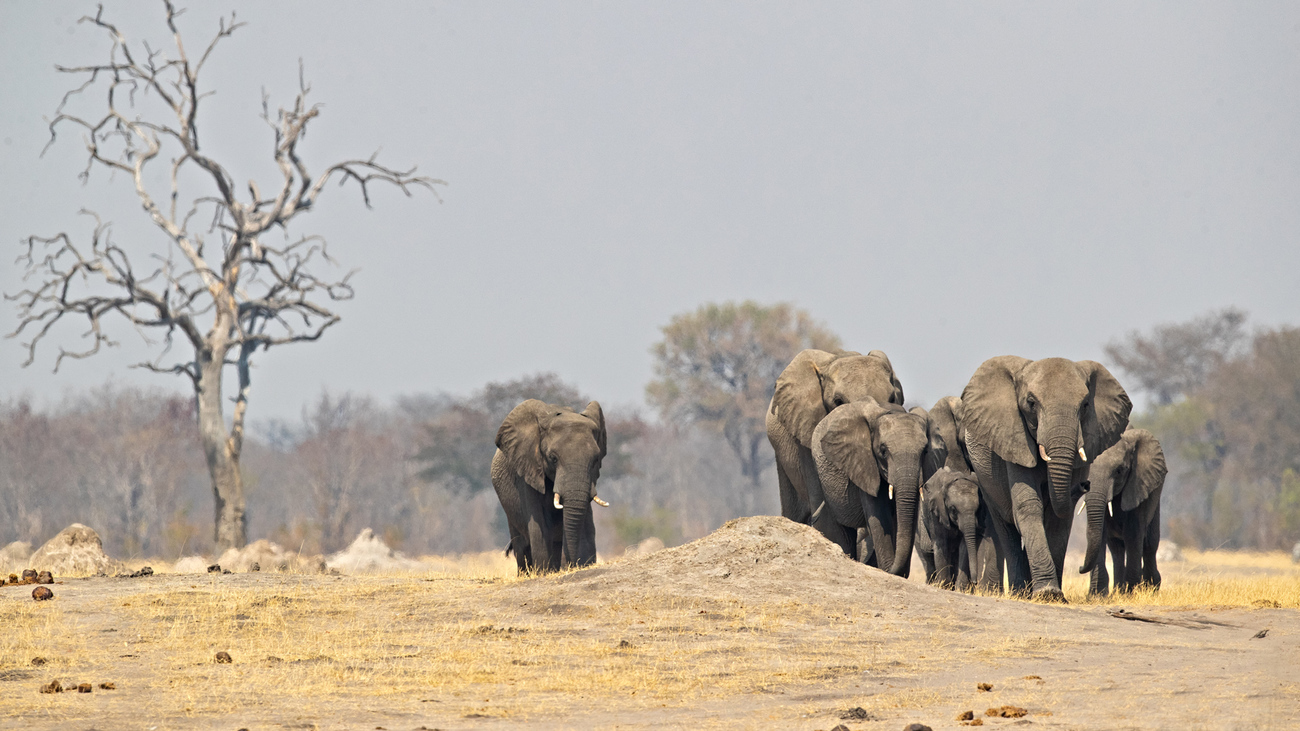
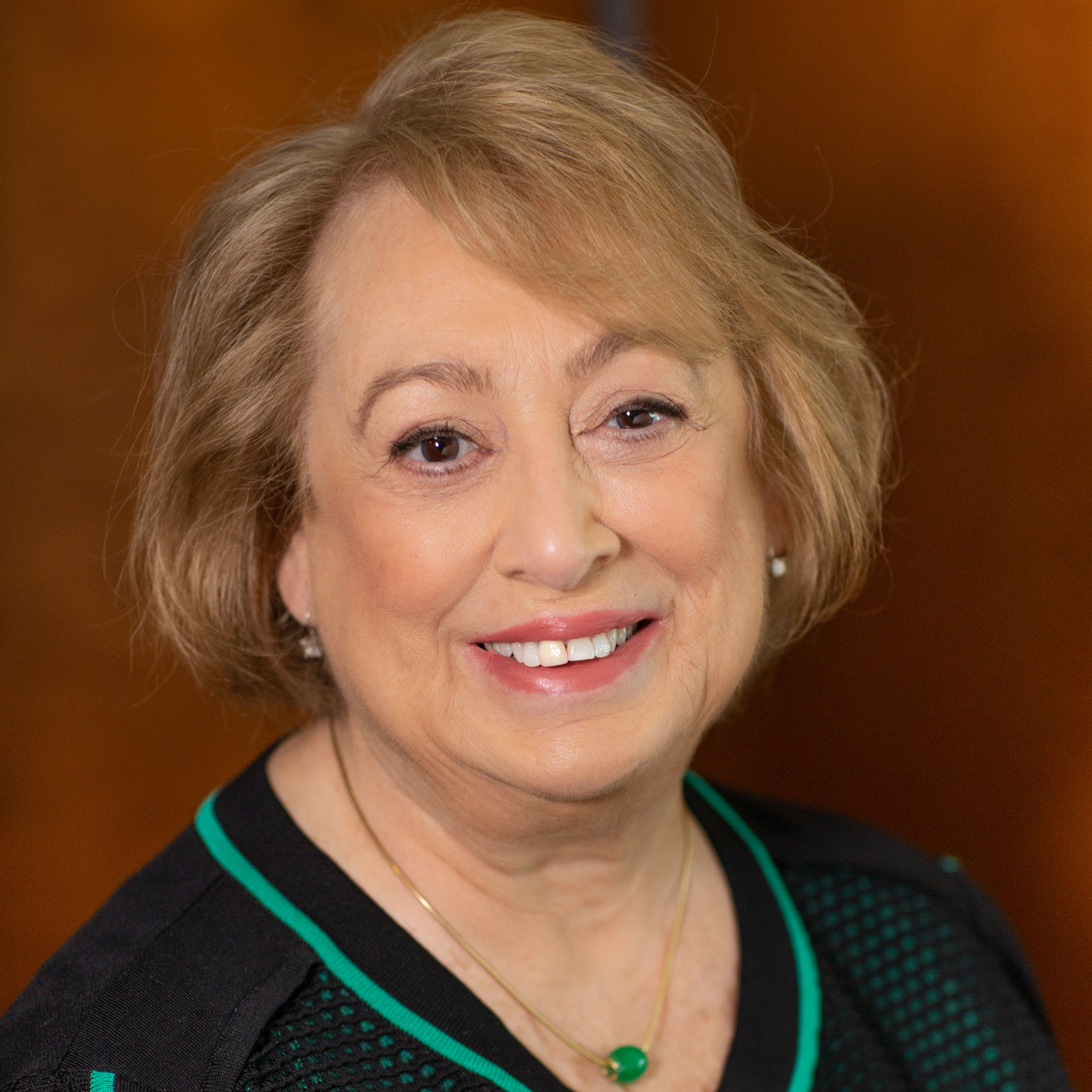
Joyce Doria
Board Chair
“Once again, I find myself humbled not only by the relentless dedication of the IFAW global team, but by the tireless support and unwavering commitment of its supporters as well. Individual donors, foundations, and representatives of governments have placed their faith in IFAW to ensure tangible results that allow both animals and people to thrive together. I thank you for supporting us as we continue our conservation journey over the next 50 years. Your commitment to this journey is as important as our own. With heartfelt thanks on behalf of the International Fund for Animal Welfare.”

Azzedine Downes
President & CEO
“Today, IFAW is better positioned than ever before to help animals and people thrive together. We have the infrastructure and the influence to take bold action, as well as the experts and partners to find solutions that work. Our commitment and our compassion over these past 50 years compel us away from a doomsday narrative so often heard around the world toward an outcome that embraces hope and recognizes the power of ordinary people to make a difference. We thank you for being a part of our collective story. But most especially, for inspiring us to save lives every day.”

landscape conservation
Much of IFAW’s work is anchored around rescue and rehabilitation of animals. But there’s a third “r” in this trilogy—release. And to safely release a wild animal to thrive and survive requires safe space. That’s why IFAW’s Landscape Conservation Program works to ensure that habitats remain healthy and viable, able to provide ecosystem functions to both animals and people who call them home.
When habitats deteriorate so do the animals who live there. People suffer too. In eight endangered landscapes around the world IFAW is empowering people to invest in their natural assets. Across Africa, in India, and in China, we are implementing community conservation projects that benefit people, reduce human-wildlife conflict and protect iconic species like elephants and their habitats.

In the spotlight: Panda-Masuie Forest Reserve—rejuvenating wildlife
Rescue and rehabilitation is an indispensable part of IFAW’s work, but it doesn’t stop there. What about when the time comes to return animals to the wild? For IFAW, finding—and securing—places to release the animals we help save is as important as saving the animals in the first place, especially as habitats are under increasing pressure due to climate change.
In Zimbabwe that place is the Panda-Masuie Forest Reserve—a vast 85,000-acre (34,000 hectares) habitat close to the world-famous Victoria Falls. This is where IFAW is supporting Wild is Life’s Zimbabwe Elephant Nursery in its mission to release into the wild the orphan elephants they have hand-reared.
Panda-Masuie was once a hunting concession, and most wildlife had learned to give it a wide berth. In the past two years, since a lease was signed that converts the area to non-hunting use, Panda-Masuie has seen a remarkable rejuvenation in the variety of species and density of wildlife.
Now large herds of wild elephants traverse the reserve, including two rescued and relocated elephants that have successfully joined one of the family groups. Lions roam, herds of up to 100 buffalo are regularly spotted and two packs of endangered wild dogs make their home in the reserve. Other rare species like leopard, caracal, vulnerable brown hyena, and bat-eared fox have returned to the Panda-Masuie forest—all species that had not been seen in years.
Investing in infrastructure and gaining the support of local communities has been crucial to the success of the project. Projects in the area now employ more than 25 people from the local Woodlands community. With at least five people supported by every job created, Panda-Masuie has become a vital support for this community.
Rangers protect Panda-Masuie’s elephants and other wildlife from the threat of poachers, patrolling many miles of the forest every day. The good news is that they are finding fewer snares and less evidence of poachers than ever. Under their watch not a single elephant has been poached on Panda-Masuie since 2017.
not a single elephant has been poached on Panda-Masuie since 2017.

wildlife crime
In our efforts to protect animals and the places they call home, we seek to end the illegal trade in wildlife species. Of the many threats to our planet’s wildlife, the illegal trade in live animals and their body parts is one of the most inhumane and detrimental to their survival. The illegal wildlife market is dependent on supply and demand, just like any other market.
By breaking every link in the criminal trade chain, we are making the world safer for animals, and for people. We’re decreasing the supply of illegal wildlife products by working with local communities and park rangers to stop poaching at its source. We engage with governments and the private sector to disrupt global trafficking networks, to prevent illegal trade from taking place in online marketplaces, and to curb the demand by raising consumer awareness and changing their behavior.

In the spotlight: law enforcement
IFAW collaborates with government and community rangers. We provide training, coaching, infrastructure, equipment (such as GPS, binoculars, air pressure horns, and torches), lothing, and other resources to prevent crimes against wild animals in the places they call home. In 15 sessions we trained more than 500 customs agents, front-line border guards, animal quarantine officers, port inspectors, environmental police and wildlife law enforcement personnel with our Detecting Illegal Species Through Prevention (DISRUPT) trainings.
In fiscal year 19 we successfully wrapped up the Horn of Africa Wildlife Crime Prevention project, which was initiated by the Dutch government and implemented under the leadership of the International Union for the Conservation of Nature—Netherlands Committee (IUCN NL). A great deal was accomplished in a short amount of time, including the establishment of a regional intergovernmental platform: The Horn of Africa Wildlife Enforcement Network. We also strengthened law enforcement capacity in Kenya and Ethiopia using community scouts to supplement national wildlife authorities.
Through our tenBoma method, we continue to organize, train, equip, and inform government and community rangers in core landscape areas to combat wildlife crime. IFAW’s tenBoma platform pioneers systems-based solutions through fresh thinking from veteran counter-terrorism experts, bold community-based projects, and key cross-sector partnerships to achieve three simple, yet powerful goals: Stopping poachers before they kill; disrupting and dismantling criminal networks; and empowering local people. This work receives support from the European Union, the TUI Care Foundation, and many generous individual donors.

training dogs to stop smuggling of wildlife from Benin
West Africa is on the rise as a region from where wildlife traffickers smuggle poached pangolins, elephants, and other wildlife to markets in Asia and Europe. We therefore developed a wildlife crime detection training program for dog units in Cotonou, Benin. The program trains dogs to detect animal parts like ivory and pangolin scales, and includes best practices and high standards for dog welfare. It also prepares the handlers, who may not have had any previous experience working with dogs. Once trained, the units will deploy to strategic locations like ports, airports, border crossings, and the boundaries of protected wildlife habitats.
In this first year, as per agreement with the government of the Republic of Benin, we focused on renovating and modernizing the existing K9 Brigade facility. Dog training began and seven dogs were Wildlife Crime law enforcement selected to continue with IFAW’s training program to become part of a dog/handler unit. Some of the dogs some from local communities or were transferred from French shelters. So far, four police officers have been selected as handlers for the detection dogs.
Kenya-Tanzania transfrontier conservation area
In the Amboseli-Tsavo-Kilimanjaro landscape 10 community wildlife rangers who graduated from an IFAW-sponsored three-month training were deployed, bringing the total number of IFAW-trained community rangers to 50. The Olgulului Community Wildlife Rangers (OCWR) were also joined by a team of eight young Maasai women who completed their initial training and now form “team lioness,” one of Kenya’s first all-female ranger units.

Uganda-DR Congo transfrontier conservation area
IFAW undertook a tenBoma-based intelligence gathering and analysis training of 16 rangers from Queen Elisabeth National Park in Uganda and two from Virunga National Park in DR Congo. In Uganda and DR Congo, another 55 law enforcement officers based at airports, seaports, border points, and in parks were trained, as well as 25 judicial and prosecutorial officers – which has increased arrests and convictions.

Malawi-Zambia transboundary landscape
With funding support from the United States Bureau of International Narcotics and Law Enforcement Affairs, IFAW teamed up with Malawi’s Department of National Parks and Wildlife (DNPW Malawi) for Operation DISRUPT. This started with a series of trainings for different law enforcement officers from Malawi, Mozambique, and Zambia. In addition, Community Enforcement Networks (CENs) were meaningfully enhanced and extended. Our efforts with Operation DISRUPT are disrupting criminal networks in the Malawi-Zambia transboundary landscape. Results so far include the seizure of 380 kilograms of ivory, two pangolins, 28 firearms, hippo teeth, and bush meat. A total of 76 arrests and charges have been made.
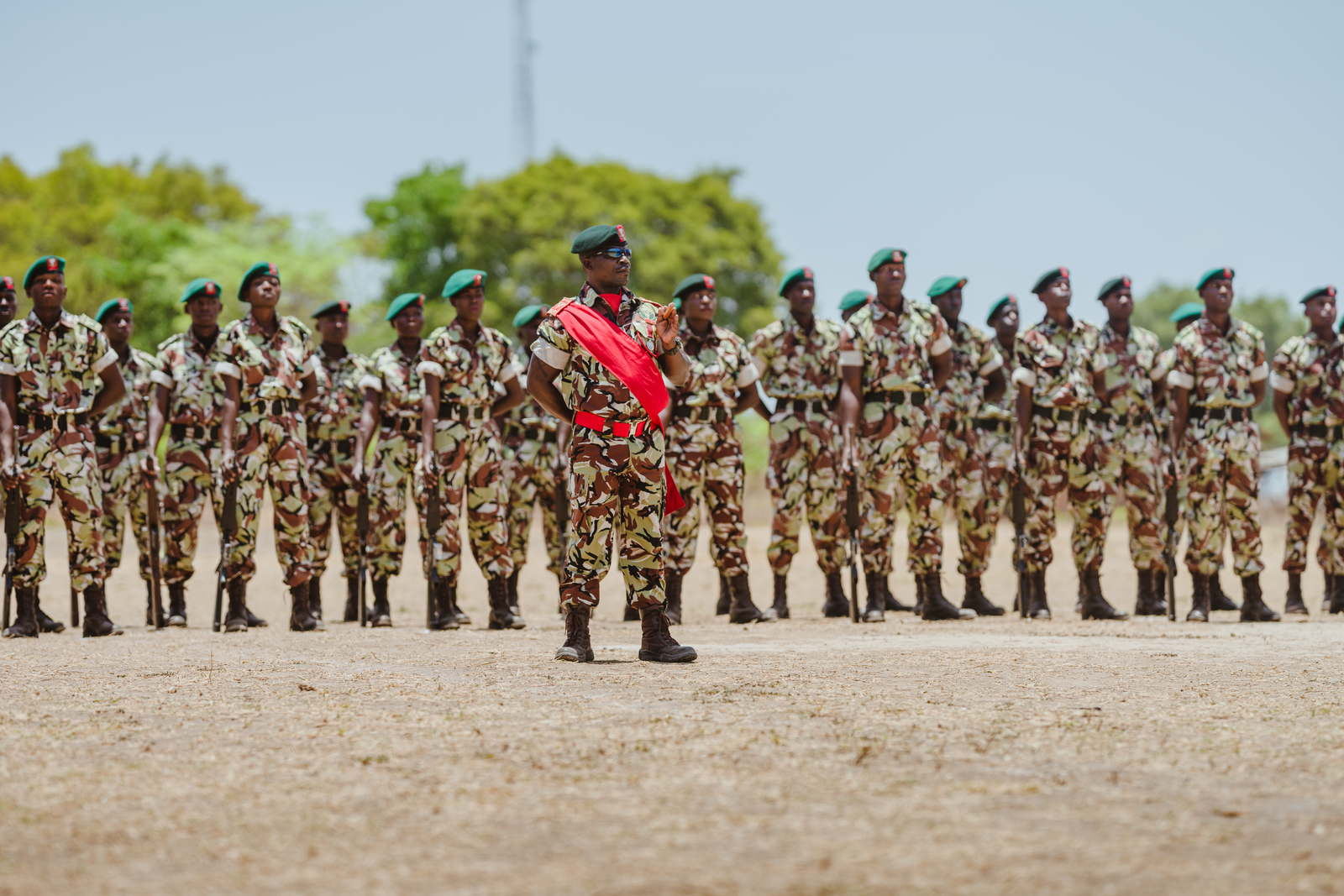
workshops and collaboration in China and Vietnam
In Asia, IFAW collaborated with Chinese government agencies and the Police Academy to build political commitment and to enhance enforcement. IFAW organized five capacity building trainings and communication workshops for more than 240 frontline law enforcement officers. We also supported two workshops that let customs agencies from China and Vietnam meet together to enhance regional coordination, communication, and collaboration to disrupt wildlife trafficking.
These workshops contributed to Vietnam Customs making four important seizures totaling 16,498 kilograms of ivory and pangolin scales and 34 kilograms of rhino horn.

watch this video to learn more about how we fight wildlife crime in Kenya and see how we partner closely with the local Maasai communities.

wildlife rescue
Our efforts to rescue, rehabilitate, and release injured and orphaned wildlife into secure habitats span five continents and include a wide variety of species. Our approach to wildlife rescue work is a commitment to best practices, building capacity, and learning from our experiences and partners.
This year presented us with thousands of animals fighting for their lives, due in part to the impact of climate change. Thanks to our global supporters we were able to achieve important milestones in rescue and release, build awareness in communities and increase the capacity of our partners to protect wildlife.
In fiscal year 19, IFAW supported the rescue, rehabilitation, and, where appropriate, the release of more than 6,700 wild animals around the world, including elephants, rhinos, big cats, primates, bears, birds, and reptiles.

elephants one step closer to life in the wild
IFAW is working closely with partners and government authorities to enable the rescue, rehabilitation and release of elephants into secure landscapes. In fiscal year 19, in three different countries, IFAW and our partners have translocated 15 elephants to protected soft release sites in or near national parks.
In Zimbabwe, IFAW has partnered with Wild is Life’s Zimbabwe Elephant Nursery, a dedicated and passionate team of expert wildlife rehabilitators, led by founder Roxy Danckwerts, to rescue five additional elephants in fiscal year 19 and translocate eight older orphans to Panda-Masuie Forest Reserve for the first phase of their release.

giving a second chance to birds of prey in China
Since 2001, IFAW’s Beijing Raptor Rescue Center (BRRC) on the grounds of Beijing Normal University has treated more than 5,000 injured raptors. In fiscal year 19, 325 raptors from eight different species were treated and 178 were released back to the skies.
The year included two monthly highs (51 cases in September 2018 and 60 in May 2019) since the Center was established, the Center’s first treatment of black-winged kites, and the release and successful post-release monitoring of a golden eagle.
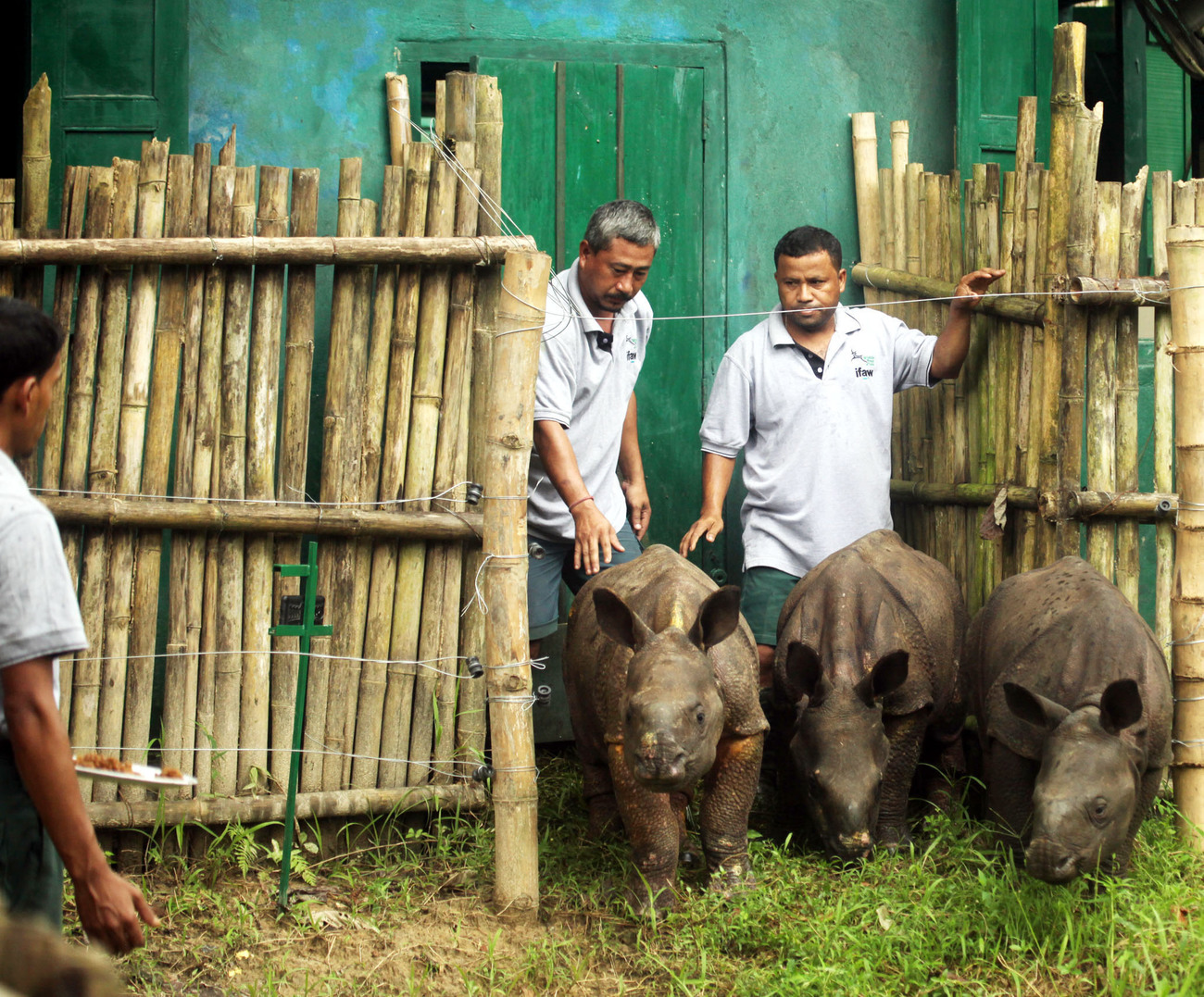
improving the odds for injured and orphaned wildlife in India
Through the Centre for Wildlife Rehabilitation and Conservation (CWRC) and Mobile Veterinary Service (MSV) units in the Assam region, IFAW and partner Wildlife Trust of India (WTI) treated 390 animals fiscal year 19 and 76% of all animals rescued were released back into the wild.
Two rhino calves were rescued during the annual Assam floods, and four others were translocated to an acclimatization enclosure in Manas National Park, a UNESCO World Heritage site that IFAW and WTI have been instrumental in restoring. When ready for life in the wild, at least two of the rhinos will be pioneers in resettling a new area of the park, called Panbari, where rhinos have been locally extinct for years.
Other milestones in fiscal year 19 included placing tracking collars on four released elephants to enable one year of post-release monitoring, rescuing 34 vultures after secondary poisoning (achieving a remarkable 88% release rate), and treating elephants, leopards, small cats, and civets.
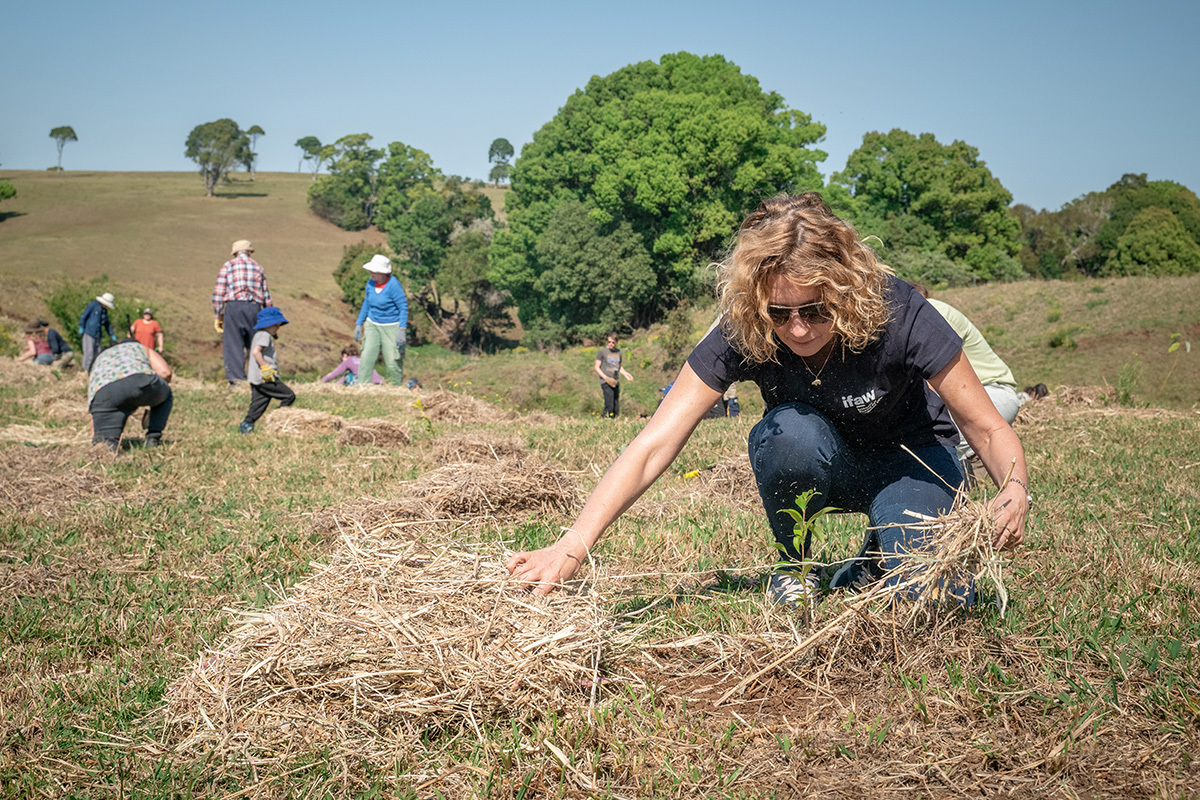
securing a future for koalas in Australia
Koala populations are declining dramatically in Australia, and habitat loss is the number one cause. In fiscal year 19, IFAW launched a holistic strategy to rescue, rehabilitate, and release koalas into secure habitats. To strengthen rescue and rehabilitation capacity in New South Wales, IFAW is supporting a veterinary position at Friends of the Koala’s Triage, Pathology and Treatment Clinic. In the first seven weeks of the position being in place (mid-May to end June 2019), 45 koalas had been treated. Increased expertise and the ability to treat immediately and onsite, rather than transport animals to other hospitals, means that more animals are saved. We aim to increase the release rates and conduct post-release monitoring as we move forward.
In South West Victoria, koalas are facing a welfare crisis due to being displaced from natural habitat into private blue gum plantations, where they become collateral damage of tree clearing and chipping. Collaborating with Port Macquarie Koala Hospital, IFAW held a veterinary workshop for 52 vets and vet nurses and sponsored the publication of the Koala Rehabilitation Manual, a go-to authoritative guide for wildlife carers.
To help secure koala habitat, IFAW launched a partnership with Bangalow Koalas to restore a 50 kilometer koala wildlife corridor in the Northern Rivers, New South Wales. 122 volunteers planted 1,500 trees in a single hour, including koala food and medicinal trees as well as rainforest species to provide canopy.
1,500 trees planted in one hour to support a koala wildlife corridor.

disaster response
We put ourselves on the frontlines of natural and manmade disasters to rescue animals in need. Fires, floods, heatwaves, and other natural disasters related to climate change seem to become ever more common, putting even more animals and habitats at risk. Over the years, we’ve rescued and rehabilitated thousands of animals threatened by natural disasters. This year alone, IFAW rescued 4,730 wild animals, an estimated 1 million bees, 14,500 companion animals, and 18,204 livestock.
From South America to Asia, we supported emergency responses in 15 countries, including Brazil, India, Pakistan, Tanzania, the United States, Guatemala, Indonesia, Mexico, Myanmar, Serbia, South Africa, France, Vietnam, Ukraine, and Australia.
intervention highlight: Sulawesi, Indonesia
Lifesaving interventions took place following the earthquake and subsequent tsunami in Sulawesi, Indonesia, in September 2018. Our Southeast Asia Animal Rescue Network provided dogs and cats with emergency veterinary care. As the disaster transitioned to recovery, the team provided pet food and temporary sheltering for community members and their animals.

intervention highlight: Butte County, California, US
Throughout November and December 2018, IFAW deployed to Butte County, California, where we provided trained search and rescue teams and temporary sheltering for pets after the devastating fire reduced the entire community of Paradise to ashes. In the weeks after the fire, IFAW led efforts to reunify hundreds of pets with their owners.

intervention highlight: Australia
A heatwave in Australia during December affected hundreds of flying foxes, who received life-saving care thanks to several organisations working together, supported by IFAW. Disaster response can be some of the most dangerous work we do, but sometimes we’re able to make the biggest difference simply by sharing expertise, helping to coordinate or providing grant funding when urgently needed.

intervention highlight: Oklahoma, US
In May 2019 we deployed to Oklahoma to support temporary sheltering for pets evacuated from flooded communities. The team then travelled to Arkansas to partner with Wings of Rescue and together we flew out 172 rescue cats and dogs to our national partners so that local animal shelters could make space for pets owned by families that were displaced or in temporary humanitarian shelters.

sometimes we’re able to make the biggest difference simply by sharing expertise, helping to coordinate or providing grant funding when urgently needed.

marine mammal rescue
The gently sloping, sandy beaches and dramatic tidal fluxes of Cape Cod, USA—home to IFAW’s Marine Mammal Rescue and Research team—make the area the world’s busiest location for cetacean (that is, dolphin and whale) strandings. For the past 20 years, we have been the first line of defense for marine mammals in distress there. We aim to provide the best triage and veterinary care possible to these animals in need and give as many as possible a second chance at life. We train first responders from around the globe in cutting-edge stranding response and our data serve as the baseline in other teams’ research globally.

our 5,000th response to help marine mammals in need
On 27 November 2018, our team responded to the 5,000th case, the same month the team celebrated its 20th anniversary. It was a remarkable milestone, in what was also IFAW’s busiest year on record, with a total of 539 responses—more than double the annual average of 251. We responded to 151 live marine mammal strandings, of which seven were rescued for further rehabilitation and 74 were assessed, treated and released safely back to the sea.
more and more successful releases
This ongoing high response rate allows us to pioneer field health assessments and treatments for stranded dolphins and whales in order to increase the likelihood of their survival after release. By gaining more insights, improving techniques, and evaluating scientific data, our successful release rate for the past year was 66%.
Looking back from where we started in November 1998, we’ve increased our dolphin release rates from 15% to more than quadruple that rate today. And that hasn’t gone unnoticed. We have spread the knowledge we’ve gained across the globe, from the United Kingdom to New Zealand, from Iceland to India. Today, IFAW is a world leader in rescuing stranded dolphins.
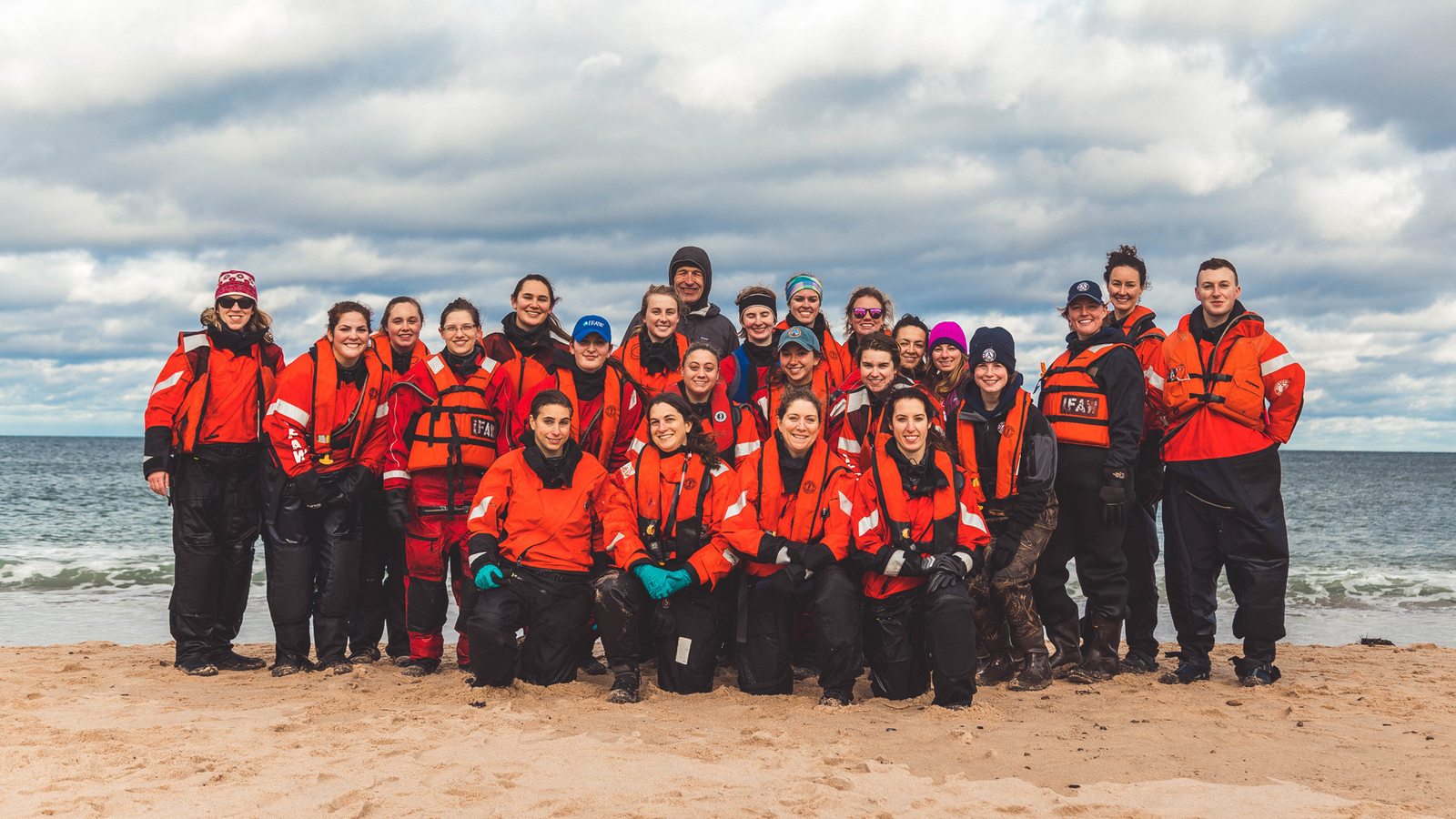
new tracking and transmitting record
We also continued the use of innovative tracking technology to help evaluate the survival of released dolphins. In 2019 we successfully released a single female Atlantic white-sided dolphin with a temporary satellite tag, which transmitted for 160 days.
This was the longest tag transmission time from one of our released cetaceans. Our efforts have shown that stranded animals not only survive after release, but thrive too. These data are used not only to improve future stranding responses, but also to shed light on how these animals navigate their ocean habitat.

leading in international marine mammal rescue and research
This year we co-hosted a stranding response and necropsy workshop at the 50th annual International Association for Aquatic Animal Medicine (IAAAM) conference in Durban, South Africa. In addition, our staff continues to share knowledge by presenting at scientific conferences and conducting trainings across the globe—this year in the United Kingdom, South Africa, Brazil, and New Zealand.

investigating mortality in one of the most endangered whales in the world
Multi-agency research led by IFAW veterinarian Dr. Sarah Sharp and published in 2019 has demonstrated that between 2003 and 2018, where cause of death could be definitively determined, no adult or juvenile North Atlantic right whale deaths were a result of natural causes. Not a single one. IFAW is determined to overcome this disheartening reality, as the loss of even one individual represents a major blow to the long-term recovery of the species as a whole.

this year our marine mammal rescue team celebrated its 20th anniversary which also coincided with their 5000th rescue. Watch this video to see how.

marine conservation
Life in the sea is under threat. As many as one million species live in our oceans, and many of them are in danger. IFAW works to protect whales and other marine species from threats including entanglements in fishing gear, collisions with fast ships, ocean noise pollution, commercial whaling, plastic litter, and climate change. Whether promoting alternative practices or lobbying for stronger laws, we focus on solutions that enable animals and people to thrive together.

In the spotlight: saving the North Atlantic right whale
For millennia, they numbered in the tens of thousands: males and females, mothers and their calves, moving slowly up and down the east coast of North America, following migratory pathways from calving grounds off Florida and Georgia to feeding grounds in coastal New England waters and the Canadian Maritimes. Known by Yankee whalers as the “right” whale to hunt, by the 20th century these gentle, slow-moving creatures had been almost completely wiped out.
Today, the North Atlantic right whale is perilously close to extinction at the hands of humans, but from two completely different causes—entanglement in commercial fishing gear and collisions with vessels. IFAW’s flagship marine conservation campaign is addressing both of these threats, giving one of the most endangered animals on the planet a fighting chance.
The North Atlantic right whales’ ancient pathway is now one of the planet’s most industrialized ocean corridors, and the intensity of human activity within this urbanized waterway has prevented the population of whales from recovering. Mortalities of adult and juvenile North Atlantic right whales are driven overwhelmingly by human-induced trauma, according to a data-driven scientific paper published in 2019, based on multi-agency research led by IFAW veterinarian Dr. Sarah Sharp.
Today, we are left with just 400 individuals, of which only 90 are reproductively viable females. Alarmingly, 30 North Atlantic right whales have died since June 2017. Through extensive advocacy efforts in both the United States and Canada, grassroots campaigning, and media outreach initiatives, IFAW is at the forefront of the effort to engage government officials, the fishing and shipping industries, and other stakeholders to take immediate action to protect the right whale and proactively preserve their habitat.
Reducing the threat of entanglement lies at the core of IFAW’s campaign. Entanglement in fishing gear causes immediate, traumatic drowning in some cases and prolonged, painful death in others, as whales constricted by ropes slowly starve. 85% of right whales have experienced entanglement at least once within their lifetime.
The past year has seen continued collaboration between IFAW and regional fishing industry associations and underwater technology manufacturers to encourage widespread adoption of “ropeless fishing gear.” This whale-safe technology eliminates vertical buoy lines in the water to allow right whales safe passage through critical habitat, ultimately ensuring the livelihoods of local fishermen while also safeguarding the survival of the right whale.
IFAW continues to encourage the private sector, government officials, and other stakeholders to endorse and adopt new approaches and technologies to reduce and ultimately eliminate these human-caused threats to right whales. Through our comprehensive action, advocacy, collaboration, and encouragement of technological innovation, IFAW will remain steadfast at the helm, setting a course for recovery of the North Atlantic right whale for generations to come.
IFAW is at the forefront of the effort to engage government officials, the fishing and shipping industries, and other stakeholders to take immediate action to protect the right whale.
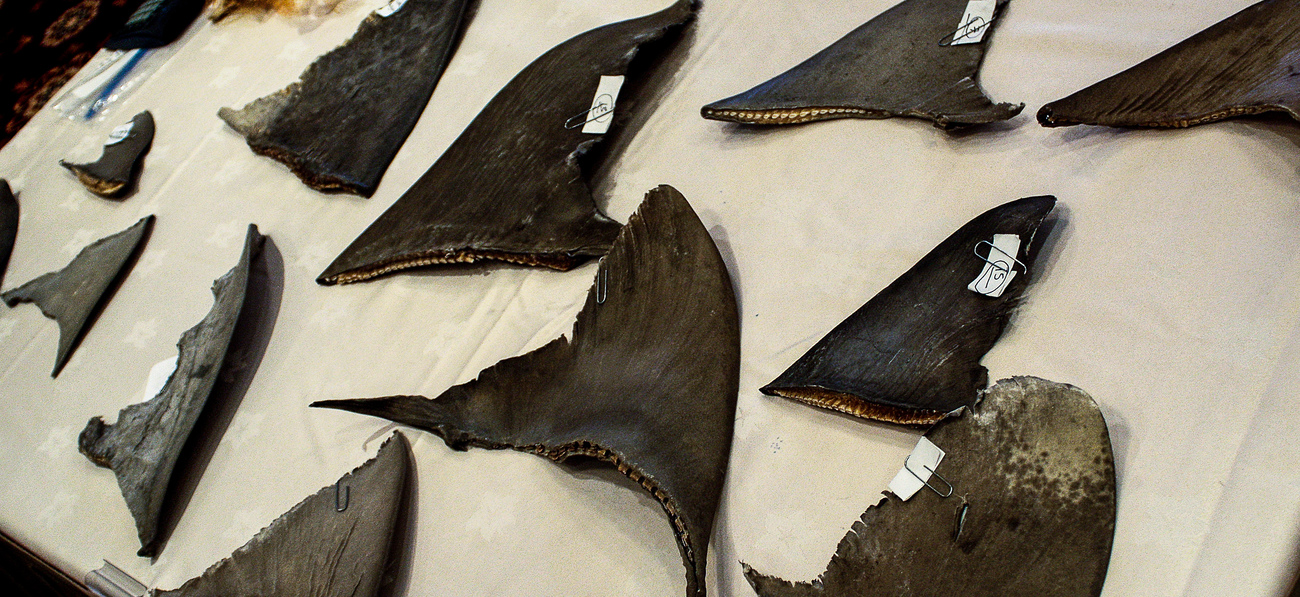
international policy
In addition to significant progress made in international agreements towards ending commercial whaling (see Marine Conservation section), there were many other important outcomes at meetings of international agreements during fiscal year 19.

The Standing Committee of CITES, the United Nations agreement that governs the international trade in wildlife and wildlife products, met in October 2018. IFAW has been working for a number of years to ensure illegal trade in wildlife on the internet is considered at CITES. The Standing Committee agreed to recommend to the CITES Conference that language around wildlife cybercrime should be strengthened.
The CITES Standing Committee also saw the launch of new proposals to list an additional 18 shark and ray species under CITES, to ensure any trade in their products is sustainable, to be discussed at the next CITES Conference. IFAW worked with Latin American countries on the idea of a regional declaration on wildlife crime to help elevate efforts in the region to tackle exploitation of wildlife across the continent.
In November 2018 Egypt hosted the 14th Convention on Biological Diversity (CBD) conference which began a process to negotiate a new framework for protecting nature. IFAW launched a report at the meeting about the importance of protecting animals for human wellbeing, making the link between why and how humans and animals can thrive together. IFAW is working to ensure a strong focus on protecting wildlife within this new framework that reflects this approach.
Every year on March 3 we celebrate World Wildlife Day. As part of the 2019 event, IFAW worked with UN partners to host an international youth art contest on this year’s theme: Life below water. IFAW announced the winner at a high-level event held at the UN headquarters in New York.
Our involvement in the aforementioned forums and the strategic relationships our participation builds with governments and institutions around the globe establishes IFAW as a trusted partner, as well as enabling us to showcase our pioneering solutions to government decision makers who drive funding and policy decisions.